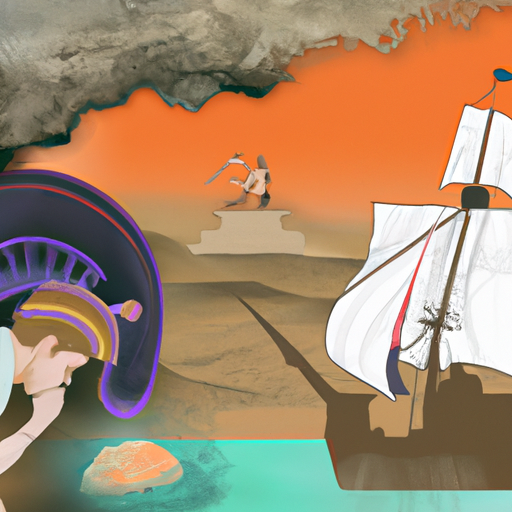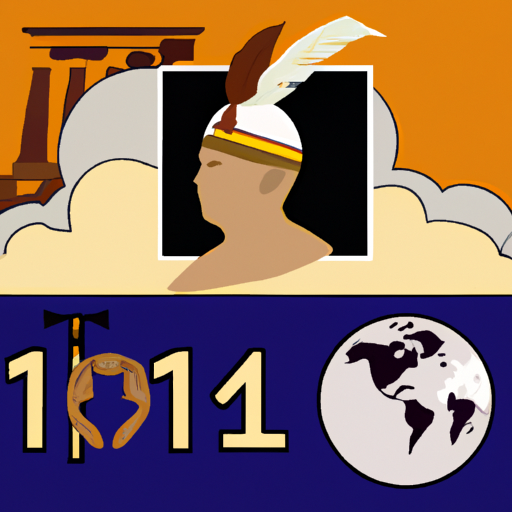History of Babylon: How an Ancient City Became Part of Today’s World
Unearthing the enigma of Babylon: Unveiling the secrets of a city that has profoundly impacted our past and present. Exploring the mysteries that lie within, delving into its depths to uncover the truth. Discovering how this metropolis has shaped our collective history and influenced our current lives. Unraveling the many facets of this ancient civilization and understanding its influence on us all.

A city of enigma, Babylon has been a source of fascination for centuries. Its impact on history is undeniable, with the city having been an influential cultural and political force from the 18th to 6th century BC. From its renowned Hanging Gardens to its vast library of clay tablets, Babylon has left a lasting impression on our collective past.
The city of Babylon was established by King Hammurabi in 1792 BC and situated in what is now Iraq. It was a bustling metropolis that served as the capital of multiple empires, such as those of the Akkadian, Neo-Babylonian and Persian Empires. The city was celebrated for its grand architecture, state-of-the-art irrigation systems and impressive temples devoted to the gods Marduk and Ishtar.
In addition to its physical structures, Babylon also left behind a wealth of written records that offer us insight into its culture and history. These encompass cuneiform tablets containing legal codes, religious texts, astronomical observations and even medical advice. By studying these artifacts we can gain invaluable knowledge into how Babylonians lived their lives thousands of years ago.
The legacy of Babylon goes beyond its physical remains or written records; it has had a deep effect on our current culture too. Many aspects of modern life have their roots in this ancient civilization; mathematics, astronomy and literature all trace back to Babylonian scholars. Even today we use concepts such as base 60 (employed by ancient Babylonians for measuring time) or words such as “talent” (which derives from a unit of measurement used in ancient Babylonia).
The secrets hidden within the walls of this enigmatic city are still being unveiled today. As we continue to explore the depths of this ancient civilization we will be able to uncover more pieces of our collective history and gain further understanding into how it has shaped our lives today – both culturally and scientifically.
.
Introduction

Mystifyingly, a once vibrant and powerful city that had been the nucleus of culture, artistry, and faith for centuries is no longer. In 539 BCE, Babylon was taken over by Cyrus the Great and its descent began. By the 1st century BCE, it had become practically deserted. All that remains today are remnants to remind us of its past grandeur.
– The History of Babylon: From Ancient City to Modern Day
For millennia, Babylon has been a place of mystery and wonderment. From a humble trading post to its eventual downfall at the hands of Alexander the Great, this ancient city is steeped in stories and events that have shaped history as we know it.
Dating back to 2300 B.C., Babylon was founded by King Sargon I and quickly became one of the most important cities in the region. Its rulers were renowned for their administrative skills, influencing law, religion, and culture throughout Mesopotamia. Additionally, its strategic location made it an ideal center for trade between Asia Minor and other nations in the area.
In 1792 B.C., Babylon became part of Hammurabi’s vast empire which stretched from Syria to Egypt. Under his rule, Babylon prospered economically due to his policy of encouraging trade with other nations and establishing a code of laws known as Hammurabi’s Code that provided citizens with protection under law and set standards for justice throughout Mesopotamia.
Unfortunately, Babylon’s independence came to an end in 539 B.C., when it was conquered by Cyrus II, king of Persia. This marked the beginning of a long period where it would be ruled by foreign powers such as Assyria, Babylonia, Persia, Greece, Rome, and eventually Ottoman Turkey before being annexed by Britain after World War I.
Today, much remains to be discovered about this ancient city as many parts are still buried beneath layers of soil or destroyed by war or natural disasters over time. Archaeologists continue to uncover artifacts from various periods in Babylon’s long history which help us better understand how this great civilization lived during its heyday thousands of years ago – making it an integral part not only Iraq’s but also world history today!
– Exploring the Historical Significance of Babylon
The city of Babylon is a place of immense antiquity, situated in the modern-day nation of Iraq. Since its inception in 2300 BC, it has been an essential part of human progress. From a humble trading post to one of the most influential empires in antiquity, Babylon’s grand narrative is replete with monumental events and accomplishments. To gain insight into this illustrious past, let us examine some of these remarkable feats.
Babylonian culture was marked by its contributions to literature and art. The Epic of Gilgamesh, one of the oldest surviving works of literature, was initially composed by the Sumerians around 2000 BC and later adapted by Babylonian scribes into its current form. This epic poem tells the story of Gilgamesh’s journey for everlasting life and his eventual recognition that death is unavoidable. In addition to literature, there are also outstanding pieces of art from this era such as the Stele of Hammurabi—a large slab inscribed with laws from King Hammurabi’s code—which provided other civilizations with an example on how to create legal systems based on justice and fairness.
The Babylonians were also pioneers in mathematics and astronomy. During their rule, they developed a system for counting numbers using base 60 (known as “sexagesimal”), which is still used today for measuring angles and timekeeping. Furthermore, they had an advanced understanding of astronomy that allowed them to accurately predict eclipses and chart constellations in the night sky.
Finally, their engineering prowess can be seen through iconic structures such as Hanging Gardens—one among the Seven Wonders of the Ancient World—and Ishtar Gate—an impressive entranceway adorned with glazed blue tiles depicting mythical beasts like dragons and bulls. These monuments demonstrate not only Babylonian inventiveness but also their commitment to creating exquisite masterpieces that remain standing today as reminders of their legacy.
In conclusion, exploring the historical significance of Babylon reveals just how much this ancient city contributed to human civilization throughout its long tenure. From literature and art to mathematics and engineering, it is evident that without Babylon there would be many aspects our modern life we would not have or take for granted today.
– How Has Babylon’s History Influenced Its Present Day Status?
A long-lasting impact of the past, Babylon’s history has been instrumental in forming its current status. Starting out as a city-state in Mesopotamia and culminating in its modern day role as a tourist hot spot, the country’s past has been integral to its evolution.
In times gone by, Babylon was one of the most influential and powerful city-states of its era. It was home to one of the earliest civilizations, with rulers that held sway over much of the Middle East. Not only was it renowned for art, architecture, and literature, but also served as a hub for trade and commerce. Its legacy is still evident today in terms of culture and identity.
Moreover, Babylon had an important part to play in religious history too. The Hanging Gardens were one of the Seven Wonders of the Ancient World and have become symbols of faith for many religions. Furthermore, Babylonian mythology heavily influenced Judaism, Christianity, and Islam—all three having roots that trace back to this period in time.
Currently, Babylon continues to be seen as an essential cultural center both within Iraq and beyond. People from all corners of the world come to marvel at its archaeological sites and monuments; additionally, it still holds significance for pilgrims due to its historic ties with different faiths across the ages.
To sum up, Babylon’s heritage has left an indelible mark on its present day status both culturally and spiritually speaking; from being a major political power in antiquity to now being a popular tourist destination—the nation’s past has certainly shaped its present identity.
– Tracing the Archaeological Evidence of Babylonian History
Exploring the archaeological remnants of Babylonian antiquity is crucial for comprehending the ancient Mesopotamian civilization. Absorbing knowledge from these relics, including artifacts, monuments, and other physical remains found in the area, can give us a glimpse into the political, social, and cultural life of this bygone society.
Dating back to around 4000 BC when the city was first established, earliest evidence of Babylonian history can be seen. During King Hammurabi’s rule from 1792-1750 BC, Babylon rose to prominence. It is believed that during this time period Hammurabi came up with a set of laws which impacted many aspects of life in Babylon such as trade and commerce. Archaeological investigations suggest that during this era the city was a significant hub for commerce and industry.
Apart from legal documents, archaeologists have discovered various objects related to day-to-day living in Babylon – pottery shards, tools used for farming and crafting items like jewelry and weapons, as well as religious items like statues and figurines – providing us with an understanding of how people lived during this period along with their beliefs and customs.
Additionally, archaeologists have uncovered monumental architecture from this era such as ziggurats (stepped pyramids) which were employed for spiritual ceremonies. By examining these structures we can gain further insight into religious practices among Babylonians as well as their engineering capabilities.
Investigating the archaeological proof of Babylonian history is indispensable for comprehending this ancient civilization. By thoroughly analyzing artifacts and monuments from this epoch we can gain a better understanding of the political structure, economic activities, social customs, and religious beliefs that shaped life in Ancient Mesopotamia.
– Examining the Historical Legacy of Babylonian Culture
Enigmatic and enthralling, the culture of Babylon spans centuries and has left an indelible mark on our world. From its ancient origins to its modern-day legacy, this civilization has had a profound effect on the way we live today. Tracing the history of Babylonian culture can provide insight into how it has shaped our society.
The first records of Babylonian culture date back to the 18th century BCE, when powerful kings such as Hammurabi established laws and codes that would become the foundation for many modern legal systems. During this time, impressive engineering feats were undertaken in the city, including an intricate irrigation system and a massive ziggurat temple complex.
Religion and mythology played a large role in Babylonian culture, with polytheistic beliefs being widely practiced throughout the region. Numerous gods were worshipped in temples built throughout the city, including Marduk, Ishtar, and Shamash. Art forms such as music and literature also flourished during this period; one example is The Epic of Gilgamesh which originated from this era.
In addition to its cultural significance, Babylonians made important contributions to mathematics and astronomy during their reign over Mesopotamia. They developed numerical systems which laid the groundwork for modern arithmetic methods while their astronomical observations enabled them to accurately predict lunar eclipses and other celestial events. These scientific advances paved the way for later generations to explore these fields further.
Today, Babylonian culture continues to be felt in various aspects of our lives. Its influence can be seen in art forms such as music and literature as well as mathematical concepts used in everyday life like algebraic equations and geometric shapes. Examining the historical legacy of Babylonian culture provides valuable insight into how this ancient civilization has shaped our world today.
conclusion

Awe-inspiring and mysterious, the forgotten ruins of Babylon still linger in the air, an ancient reminder of a past civilization. Shrouded in time and mystery, this once grand city holds secrets untold, its presence a lingering reminder of days gone by. Its walls have seen many generations pass, yet its history remains an enigma to modern man. We may never know what truly transpired within these walls, but its ruins remain as a silent witness to our collective past.
.
Some questions with answers
Q1: Is Babylon a city today?
A1: No, Babylon is not a city today.
Q2: What was the history of Babylon?
A2: Babylon was an ancient city located in Mesopotamia, which is now modern-day Iraq. It was one of the most powerful and influential cities in the ancient world.
Q3: When did Babylon become a major city?
A3: Babylon became a major city around 2000 BC under the rule of King Hammurabi.
Q4: What happened to Babylon after its peak?
A4: After its peak, Babylon declined due to its lack of resources and military power. Eventually, it was conquered by the Persian Empire in 539 BC.
Q5: Is there anything left of Babylon today?
A5: Yes, there are still some ruins that remain from the ancient city of Babylon. These include parts of the famous Ishtar Gate and some sections of the outer walls.




